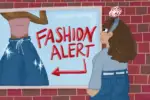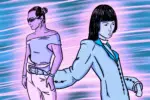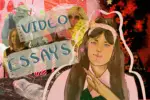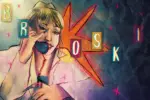The first video in Gucci’s mini-series “Ouverture Of Something That Never Ended” begins with a shot of a balcony bathed in bright sunlight before the camera slowly pulls into the hallway that leads to it. It’s giving the illusion that the audience is always watching and that Gucci is a performance, made to be appreciated but never quite within reach. With eerie bass-filled music permeating the background, you get the sense this is supposed to be an out-of-body experience. With very “Black Mirror” vibes, we’re uncertain as to what the first episode of Gucci’s “Overture Fashion” mini-series could really be about, but then we see the clothes.
Presenting their spring and summer collection with Silvia Calderoni as the star of the show, episodes of “Overture of Something That Never Ended” follow Silvia through what seems to be a typical day for her. With scenes at home, at the post office and at the cafe, we are supposed to get a sense that the clothes themselves have identities as we see them moving and interacting with day-to-day life. However, the series seemingly tries too hard at making the mundane seem sublime. It’s possible that this level of disconnect shows us more than we think about the fashion industry and what it means to our evolving society.
Fiction Versus Reality
Italian designer and Gucci creative director Alessandro Michele had a vision for “turning fashion inside-out, and revealing the typically behind-the-scenes moving parts.” But for a mini-series that seems to stress the importance of identity and fashion as an expressive form that reflects identity, Gucci’s “Ouverture Of Something That Never Ended” seems to display an overly romantic quality to the point that the message gets lost.
In the first episode, “At Home,” Silvia does a morning stretch with the TV on in the background. On screen, the audience gets to hear a one-sided conversation about the nonconforming binaries of gender and sexuality in a way that allows the viewer to feel as if the message is made for them to listen to and interpret. On the one hand, it’s a positive promotion and representation of people of the LGBTQ+ community, especially with Silvia as a trans woman representing Gucci’s clothes.
It also further promotes the statement Michele made about his goal for his new collection and the future of Gucci as he attempts to “eliminate the distinction between menswear and womenswear in fashion.” It’s a huge step for a high fashion brand to move toward inclusivity and diversity, but it ultimately fails to meet the episode’s standards for “realism” in its portrayal of what it means to be a trans woman in these spaces.
Everything is very fantastical and doesn’t give much room for real conversation. All we perceive is what we hear on the television and the way Silvia reacts to it. So, aside from the positive aspect of empowerment, what place does Silvia actually have in this narrative? And where is the behind-the-scenes conversation that Michele seemed to promise as a step toward social progress?
The truth is, many people can’t really relate to the lives that are being represented in high fashion despite the identities that are diversifying and claiming this space. “Elitism” in high fashion still seems to be the norm. For example, “Ouverture Of Something That Never Ended” has no plus-sized models, despite the fact that most people do not fit within the three or four smallest sizes. “Ouverture Of Something That Never Ended” tries to be progressive in the way it introduces nonbinary fashion and relevant topics such as the world’s climate crisis, LGBTQ+ representation and what it means to be an artist with social responsibility, but it misses the mark.
The same “diverse” and “inclusive” narratives that it tries to present are so specific that some communities are once again left out of the conversation. Silvia discusses the climate crisis in “At the Cafe” episode but there’s no mention of the fact that high fashion materials add to material waste. This is not to say that Gucci has not made efforts to help the environment, especially under Michele’s direction, but the language seems to skim over anything concrete. The video’s language is poetic and employs flowery prose, which fits the subject matter — the spring and summer collection — but it seems to try too hard to add lightness to serious topics and there’s no attempt to understand them on a deeper level.
The Future of Fashion
The fashion industry is inherently exclusive. Its world includes VIP lists, backstage passes and exorbitant price tags. But this year, because of COVID-19, they’ve been forced to move to a more public space: the internet. This is partly positive because it’s allowing “normal” people who can’t always afford to attend fashion shows to look and participate in the behind-the-scenes of the fashion industry.
Rihanna’s Savage X Fenty show that aired in October was a take on modernizing the fashion industry and the ways in which we can interact with clothes in different mediums. We got to see her lingerie collection represent a variety of people from diverse backgrounds, emphasizing inclusivity and the people it sets out to serve. But for Gucci, becoming “progressive” isn’t the same as being progressive. In order to appeal to those who don’t typically consume these brands, Gucci might have to break the bubble that high fashion exists in. I don’t claim Fenty Beauty to be high fashion on the same level as Gucci or Prada, and it definitely has had its issues, but because of its positive reception from the wider community it sets to serve, Gucci should take notes. But then again, maybe that’s not the point of high fashion — and that’s the problem.
The Clothes
One thing I could appreciate from “Ouverture Of Something That Never Ended” was the way clothes were integrated into the scenes artistically. From the focus on texture when we see a male model slipping into a red Gucci shirt in the mirror after shaving, to the patent leather bag artfully placed on a seat as Silvia slips a letter inside, the stylistic elements of the short films beautifully portray the 96-piece collection.
Displaying the variety of colors, textures and creative styles was perfect for bringing light and fun fashion pieces into the new season during a depressing time in the world. However, I thought that the use of artists like Billie Eilish and Harry Styles to promote these pieces was another marketing gimmick to bring the collection more attention instead of promoting the conversations that Michele claims to want to talk about.
Overall, Gucci’s “Ouverture Of Something That Never Ended” brings attention to the way the fashion industry needs to be more inclusive in order to stay relevant, similar to how they needed to adapt to the COVID-19 crisis and move their shows online — though that doesn’t necessarily mean they’re doing so successfully. It made me question why high fashion still exists when those who look up to these brands rarely have access to them and the people who aren’t represented in the first place aren’t the ones who are creating the content we are seeing. But then I realized that maybe high fashion was never made for the underrepresented in these spaces to begin with, so maybe I’m never going to be the person to enjoy this sort of content anyway.
















